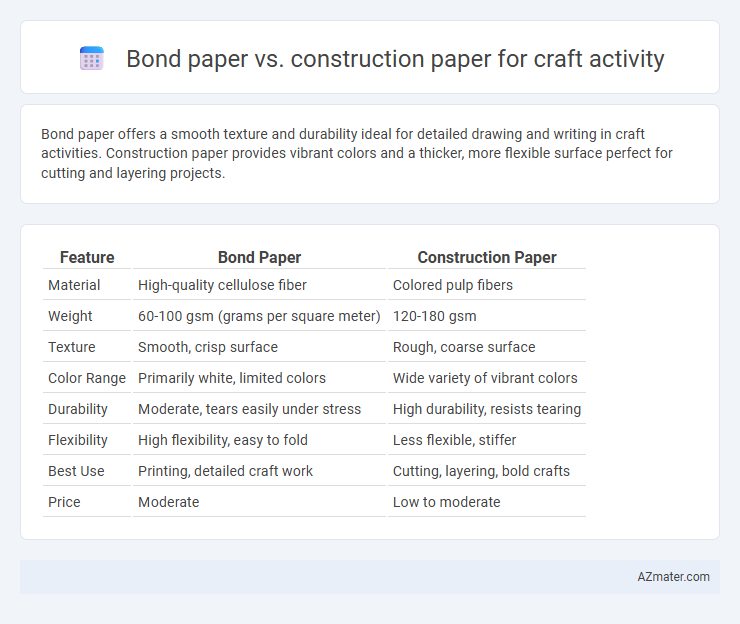Bond paper offers a smooth texture and durability ideal for detailed drawing and writing in craft activities. Construction paper provides vibrant colors and a thicker, more flexible surface perfect for cutting and layering projects.
Table of Comparison
| Feature | Bond Paper | Construction Paper |
|---|---|---|
| Material | High-quality cellulose fiber | Colored pulp fibers |
| Weight | 60-100 gsm (grams per square meter) | 120-180 gsm |
| Texture | Smooth, crisp surface | Rough, coarse surface |
| Color Range | Primarily white, limited colors | Wide variety of vibrant colors |
| Durability | Moderate, tears easily under stress | High durability, resists tearing |
| Flexibility | High flexibility, easy to fold | Less flexible, stiffer |
| Best Use | Printing, detailed craft work | Cutting, layering, bold crafts |
| Price | Moderate | Low to moderate |
Introduction to Bond Paper and Construction Paper
Bond paper, known for its smooth texture and high durability, is commonly used in professional documents and precise craft projects requiring clean lines and fine details. Construction paper features a rougher texture and thicker weight, making it ideal for colorful, hands-on art activities like cutting, folding, and layering. Choosing between bond paper and construction paper depends on the project's complexity, desired finish, and the type of materials that best support creative expression and durability.
Key Differences Between Bond Paper and Construction Paper
Bond paper features a smooth surface and higher opacity, making it ideal for detailed printing and writing in craft activities, whereas construction paper has a rough texture and vibrant colors suited for cutting, folding, and collage projects. Bond paper typically comes in standard white or neutral tones with a lighter weight around 20-24 lb, while construction paper is thicker, usually around 67-80 lb, and available in a broad color spectrum for visual impact. The durability of construction paper supports more vigorous handling and layering, contrasting with bond paper's suitability for finer art and precision tasks.
Texture and Surface Quality Comparison
Bond paper offers a smooth and uniform texture, ideal for detailed drawing and precise cutting in craft activities, ensuring clean lines and a professional finish. Construction paper features a rougher, more fibrous surface, providing a tactile, rustic quality that enhances projects requiring glue adhesion and layering effects. The choice between these papers depends on the desired texture; bond paper suits fine, polished crafts, while construction paper excels in textured, colorful art projects.
Durability for Craft Activities
Bond paper offers moderate durability with a smooth surface ideal for detailed drawing and light crafting, but it may tear or wrinkle under heavy manipulation. Construction paper provides superior durability for craft activities due to its thicker, coarser texture that withstands cutting, folding, and gluing without easily tearing. For projects requiring robust handling and layering, construction paper is the preferred choice because of its resistance to wear and suitability for a variety of craft techniques.
Color Availability and Options
Bond paper offers a wide range of color options, including pastels, neons, and vibrant hues, making it ideal for detailed craft projects requiring various shades. Construction paper typically features a limited color palette focused on primary and secondary colors, providing bold and saturated tones perfect for simple crafts and children's activities. The broader color availability of bond paper allows for more intricate and colorful designs compared to the standard options of construction paper.
Suitability for Different Art Mediums
Bond paper offers a smooth, durable surface ideal for ink, pencil, and marker use, ensuring crisp lines and minimal bleeding, making it suitable for detailed drawing and calligraphy. Construction paper features a rougher texture and thicker composition, which excels with chalk, crayon, and paint applications but may cause ink to feather or bleed. Choosing between bond and construction paper depends on the art mediums involved, where precision work benefits from bond paper, while vibrant, textured projects perform better on construction paper.
Cost Efficiency and Accessibility
Bond paper offers greater cost efficiency for craft activities due to its widespread availability and lower price per sheet, making it ideal for large projects or classrooms on a budget. Construction paper, while slightly more expensive and less uniform in size, is accessible in a variety of vibrant colors and textures that enhance creative projects but may require higher expenditure over time. Choosing between bond and construction paper depends on balancing budget constraints with the desired visual impact and material properties for specific craft needs.
Environmental Impact and Sustainability
Bond paper, typically made from wood pulp with chemical bleaching processes, often has a higher environmental footprint due to energy-intensive production and lower recyclability compared to construction paper. Construction paper is commonly produced from recycled materials and uses fewer chemical treatments, making it a more sustainable choice for craft activities with a reduced impact on deforestation and pollution. Choosing construction paper supports eco-friendly crafting by minimizing waste and promoting the use of recycled fibers.
Best Uses for Bond Paper in Crafts
Bond paper is ideal for detailed drawing, printing, and precise paper crafts due to its smooth texture and durability, making it perfect for origami, greeting cards, and high-quality prints. It holds ink exceptionally well, ensuring sharp images and vibrant colors that are essential in intricate craft projects. Unlike construction paper, bond paper resists tearing and warping, providing a professional finish for scrapbook pages and handmade invitations.
Best Uses for Construction Paper in Crafts
Construction paper is ideal for craft projects requiring vibrant colors and easy cutting, making it perfect for children's art activities, scrapbooking, and paper mosaics. Its rough texture and thickness provide durability and the ability to hold paint, glue, and markers without warping. Unlike bond paper, construction paper is less suited for detailed printing but excels in hands-on crafts that emphasize color variety and tactile elements.

Infographic: Bond paper vs Construction paper for Craft activity
 azmater.com
azmater.com